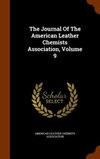Application of some Plant Extracts as Biocolorants for Leather During Finishing Process
IF 0.5
4区 工程技术
Q4 CHEMISTRY, APPLIED
Journal of The American Leather Chemists Association
Pub Date : 2024-01-02
DOI:10.34314/jalca.v119i1.8289
引用次数: 0
Abstract
In this research, chrome-tanned bovine crust leathers were dyed during the finishing process using plant extracts: walnut shell (Juglans regia), oak bark (Quercus cortex), and onion peel (Allium cepa). In this study, the standard recipe applied by the factory was used in the leather finishing process. For this recipe, various plant extracts were used instead of pigments, and groups that did not contain pigment and any dyestuff were formed as the control groups. After these processes, color measurement analyzes were performed on Konica Minolta CM 3600d spectrophotometer. In order to investigate the effects of walnut shell (Juglans regia), oak bark (Quercus cortex), and onion peel (Allium cepa) on the other performance properties of leather, dry and wet rub fastness test according to standard method TS EN ISO 11640 (2001) was performed. The results of the study were statistically evaluated using the NCSS method (Number Cruncher Statistical System). As a result of the study, it was noticed that, depending on the extract, different colors were obtained. It was found that the dry and wet fastness of leathers treated with plant extracts improved.一些植物提取物作为生物着色剂在皮革涂饰过程中的应用
在这项研究中,铬鞣牛皮在涂饰过程中使用了植物提取物染色:核桃壳(Juglans regia)、橡树皮(Quercus cortex)和洋葱皮(Allium cepa)。在本研究中,工厂在皮革涂饰过程中使用的是标准配方。在该配方中,使用了各种植物提取物代替颜料,并将不含颜料和任何染料的组作为对照组。为了研究核桃壳(Juglans regia)、橡树皮(Quercus cortex)和洋葱皮(Allium cepa)对皮革其他性能的影响,根据标准方法 TS EN ISO 11640(2001)进行了干湿摩擦牢度测试。研究结果采用 NCSS 方法(数字破碎统计系统)进行统计评估。研究结果表明,不同的提取物会产生不同的颜色。研究发现,用植物提取物处理过的皮革的干牢度和湿牢度都有所提高。
本文章由计算机程序翻译,如有差异,请以英文原文为准。
求助全文
约1分钟内获得全文
求助全文
来源期刊

Journal of The American Leather Chemists Association
工程技术-材料科学:纺织
CiteScore
1.30
自引率
33.30%
发文量
29
审稿时长
3 months
期刊介绍:
The Journal of the American Leather Chemists Association publishes manuscripts on all aspects of leather science, engineering, technology, and economics, and will consider related subjects that address concerns of the industry. Examples: hide/skin quality or utilization, leather production methods/equipment, tanning materials/leather chemicals, new and improved leathers, collagen studies, leather by-products, impacts of changes in leather products industries, process efficiency, sustainability, regulatory, safety, environmental, tannery waste management and industry economics.
 求助内容:
求助内容: 应助结果提醒方式:
应助结果提醒方式:


